Related Research Articles

Veracruz, formally Veracruz de Ignacio de la Llave, officially the Free and Sovereign State of Veracruz de Ignacio de la Llave, is one of the 31 states which, along with Mexico City, comprise the 32 Federal Entities of Mexico. Located in eastern Mexico, Veracruz is bordered by seven states, which are Tamaulipas, San Luis Potosí, Hidalgo, Puebla, Oaxaca, Chiapas, and Tabasco. Veracruz is divided into 212 municipalities, and its capital city is Xalapa-Enríquez.
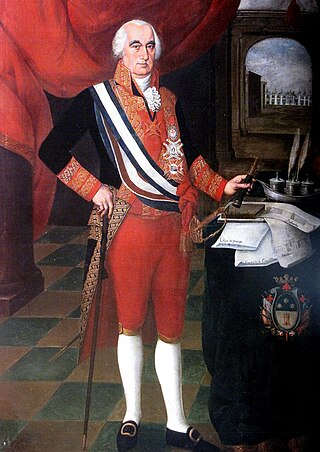
José Fernando de Abascal y Sousa, 1st Marquess of Concordia, KOS, was a Spanish military officer and colonial administrator in America. From August 20, 1806, to July 7, 1816, he was viceroy of Peru, during the Spanish American wars of independence.

The Totonac are an indigenous people of Mexico who reside in the states of Veracruz, Puebla, and Hidalgo. They are one of the possible builders of the pre-Columbian city of El Tajín, and further maintained quarters in Teotihuacán. Until the mid-19th century they were the world's main producers of vanilla.

Papantla is a city and municipality located in the north of the Mexican state of Veracruz, in the Sierra Papanteca range and on the Gulf of Mexico. The city was founded in the 13th century by the Totonacs and has dominated the Totonacapan region of the state since then. This is the home of vanilla, which is native to this region, the Danza de los Voladores and the El Tajín archeological site, which was named a World Heritage Site. Papantla still has strong communities of Totonacs who maintain the culture and language. The city contains a number of large scale murals and sculptures done by native artist Teodoro Cano García, which honor the Totonac culture. The name Papantla is from Nahuatl and most often interpreted to mean "place of the papanes". This meaning is reflected in the municipality's coat of arms.

Guadalupe Victoria, born José Miguel Ramón Adaucto Fernández y Félix, was a Mexican general and political leader who fought for independence against the Spanish Empire in the Mexican War of Independence. He was a deputy in the Mexican Chamber of Deputies for Durango and a member of the Supreme Executive Power following the downfall of the First Mexican Empire. After the adoption of the Constitution of 1824, Victoria was elected as the first president of the United Mexican States.
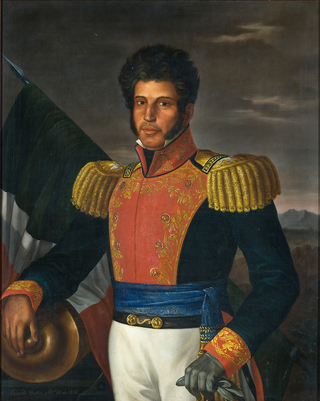
Vicente Ramón Guerrero was a Mexican soldier and statesman who become the nation's second president. He was one of the leading generals who fought against Spain during the Mexican War of Independence.

Juan José Ruiz de Apodaca y Eliza, 1st Count of Venadito, OIC, OSH, KOC was a Spanish naval officer and viceroy of New Spain from 20 September 1816 to 5 July 1821, during Mexico's War of Independence.

The Mexican War of Independence was an armed conflict and political process resulting in Mexico's independence from Spain. It was not a single, coherent event, but local and regional struggles that occurred within the same period, and can be considered a revolutionary civil war.

Totonacapan refers to the historical extension where the Totonac people of Mexico dominated, as well as to a region in the modern states of Veracruz and Puebla. The historical territory was much larger than the currently named region, extending from the Cazones River in the north to the Papaloapan River in the south and then west from the Gulf of Mexico into what is now the Sierra Norte de Puebla region and into parts of Hidalgo. When the Spanish arrived, the Totonac ethnicity dominated this large region, although they themselves were dominated by the Aztec Empire. For this reason, they allied with Hernán Cortés against Tenochtitlán. However, over the colonial period, the Totonac population and territory shrank, especially after 1750 when mestizos began infiltrating Totonacapan, taking political and economic power. This continued into the 19th and 20th centuries, prompting the division of most of historical Totonacpan between the states of Puebla and Veracruz. Today, the term refers only to a region in the north of Veracruz where Totonac culture is still important. This region is home to the El Tajín and Cempoala archeological sites as well as Papantla, which is noted for its performance of the Danza de los Voladores.
The Totonacan languages are a family of closely related languages spoken by approximately 290,000 Totonac and Tepehua people in the states of Veracruz, Puebla, and Hidalgo in Mexico. At the time of the Spanish conquest Totonacan languages were spoken all along the gulf coast of Mexico. During the colonial period, Totonacan languages were occasionally written and at least one grammar was produced. In the 20th century the number of speakers of most varieties have dwindled as indigenous identity increasingly became stigmatized encouraging speakers to adopt Spanish as their main language.
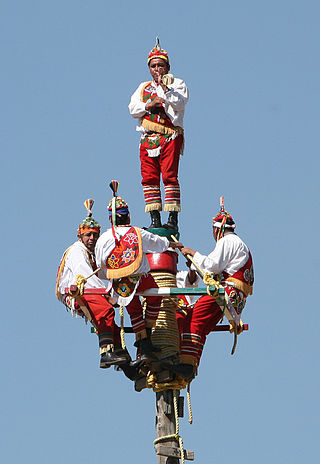
The Danza de los Voladores, or Palo Volador, is an ancient Mesoamerican ceremony/ritual still performed today, albeit in modified form, in isolated pockets in Mexico. It is believed to have originated with the Nahua, Huastec and Otomi peoples in central Mexico, and then spread throughout most of Mesoamerica. The ritual consists of dance and the climbing of a 30-meter pole from which four of the five participants then launch themselves tied with ropes to descend to the ground. The fifth remains on top of the pole, dancing and playing a flute and drum. According to one myth, the ritual was created to ask the gods to end a severe drought. Although the ritual did not originate with the Totonac people, today it is strongly associated with them, especially those in and around Papantla in the Mexican state of Veracruz. The ceremony was named an Intangible cultural heritage by UNESCO in order to help the ritual survive and thrive in the modern world. The Aztecs believed that Danza de los Voladores was the symbol of their culture.

Tecolutla is a town and municipality located on the Tecolutla River on the eastern coast of the state of Veracruz in Mexico. It has the closest beaches to Mexico City, and much of its economy is based on tourism, as it is only a four- or five-hour drive from the capital. It is the northern end of a tourist corridor along the Gulf of Mexico called the "Emerald Coast," which extends down to the city of Veracruz.

The Sierra Norte de Puebla is a rugged mountainous region accounting for the northern third of the state of Puebla, Mexico. It is at the intersection of the Trans-Mexican Volcanic Belt and the Sierra Madre Oriental, between the Mexican Plateau and the Gulf of Mexico coast. From the Mesoamerican period to the 19th century, this area was part of a larger region called Totonacapan, and area dominated by the Totonac people, extending further east to the Gulf of Mexico. Political maneuvers to weaken the Totonacs led to the region being divided between the modern states of Puebla and Veracruz with the Puebla section given its current name. Until the 19th century, the area was almost exclusively indigenous, with the four main groups still found here today, Totonacs, Nahuas, Otomis and Tepehuas, but coffee cultivation brought in mestizos and some European immigrants who took over political and economic power. While highly marginalized socioeconomically, the area has been developed heavily since the mid 20th century, especially with the building of roadways linking it to the Mexico City area and the Gulf coast.

The royalists were the people of Hispanic America and European that fought to preserve the integrity of the Spanish monarchy during the Spanish American wars of independence.

The Spanish American wars of independence were numerous wars in Spanish America with the aim of political independence from Spanish rule during the early 19th century. These began shortly after the start of the French invasion of Spain during the Napoleonic Wars. Thus, the strict period of military campaigns would go from the battle of Chacaltaya (1809), in present-day Bolivia, to the battle of Tampico (1829), in Mexico.

Antonio de Padua María Severino López de Santa Anna y Pérez de Lebrón, usually known as Santa Anna or López de Santa Anna, was a Mexican caudillo who served as president of Mexico multiple times. He was a preeminent figure in Mexican politics to the point that historians of Mexico often refer to three decades after Mexican independence as the "Age of Santa Anna". He has been called "the Man of Destiny who loomed over his time like a melodramatic colossus, the uncrowned monarch".
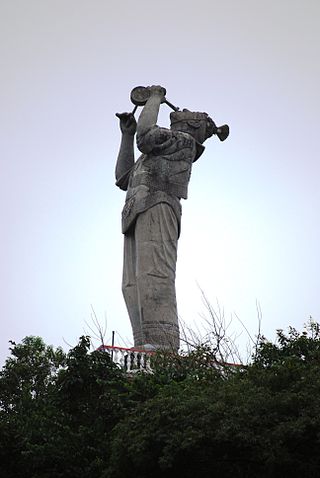
Teodoro Cano Garcia is an artist from Papantla, Veracruz, Mexico who is best known for his mural work depicting the Totonac culture of his native region in northern Veracruz. Cano was discovered by Diego Rivera, who helped Cano as a youth enter the prestigious San Carlos Academy and then employed him as an assistant with the mural work being done at the Ciudad Universitaria in Mexico City. Cano painted his first solo mural in 1953, and since then has produced paintings, murals, sculptures, photography, book illustrations and more, including creating a high relief technique with a cement base. However, Cano is best known for his mural work which depicts and promotes the Totonac culture, and much of his work can be seen in his hometown, including a monumental sculpture of a Volador dancer overlooking the city. Cano also worked as an academic for over 36 years, recently retiring, but he continues to work as an artist based in Xalapa.
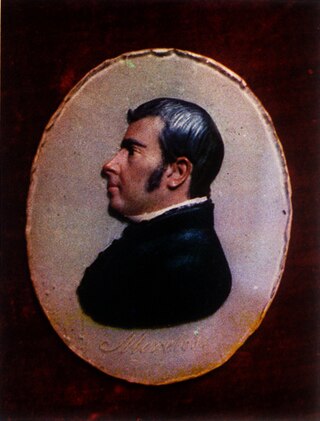
The Battle of Zitlala was a battle of the War of Mexican Independence that occurred on 26 October 1812 in the area around Escamela, Ixtaczoquitlán, Veracruz. The battle was fought between the royalist forces loyal to the Spanish crown, and the Mexican rebels fighting for independence from the Spanish Empire. The battle resulted in a victory for the Mexican rebels.

The siege of Cuautla was a battle of the War of Mexican Independence that occurred from 19 February through 2 May 1812 at Cuautla, Morelos. The Spanish royalist forces loyal to the Spanish, commanded by Félix María Calleja, besieged the town of Cuautla and its Mexican rebel defenders fighting for independence from the Spanish Empire. The rebels were commanded by José María Morelos y Pavón, Hermenegildo Galeana, and Mariano Matamoros. The battle results are disputed, but it is generally agreed that the battle resulted more favorably for the Spanish whose siege was ultimately successful with the Mexican withdrawal on 2 May 1812.

The Battle of Azcapotzalco,, was fought on August 19, 1821, in the town of Azcapotzalco, near Mexico City. It was to be one of the last military action of the Mexican War of Independence. The insurgents, commanded by the colonels Anastasio Bustamante and Luis Quintanar, fought the Spanish forces commanded by Manuel de la Concha.
References
- 1 2 3 4 5 6 7 "Personajes Ilustres de Veracruz".
- 1 2 3 Miguel Covarrubias, "Mexico South: The Isthmus of Tehuantepec", Routledge, 1986, pg. 8,
- ↑ Luis Salas Garcia, "Juu Panantlan", 1979, pg. 69,
- 1 2 Bruce G. Trigger, Richard E. W. Adams, Wilcomb E. Washburn, Murdo J. MacLeod, "The Cambridge history of the native peoples of the Americas", Cambridge University Press, 2000, pgs. 287-288,
- 1 2 3 4 5 Michael T. Ducey, "Village, Nation, and Constitution: Insurgent Politics in Papantla, Veracruz, 1810-1821", Hispanic American Historical Review 79.3 (1999) 463-493,
- ↑ Marta Terán, José Antonio Serrano Ortega, "Las guerras de independencia en la América española", El Colegio de Michoacán A.C., 2002, pg. 234,
- ↑ Enciclopedia de los Municipios de México, Estado de Veracruz, Paplanta Archived 2010-02-19 at the Wayback Machine